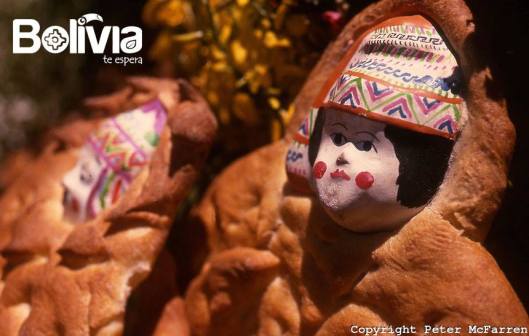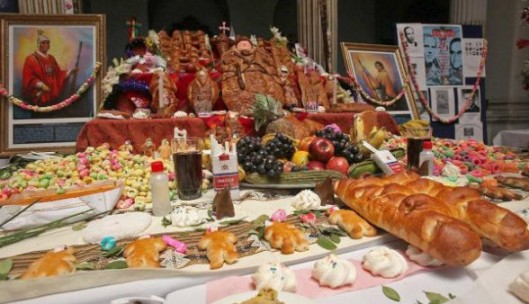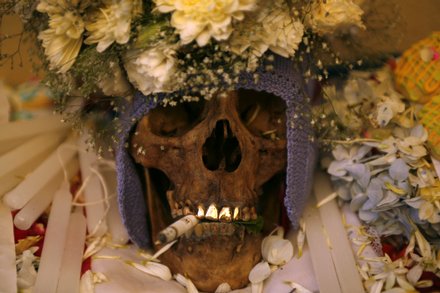’33 – letni mezczyzna o imieniu Juvenal, alkoholik od 14 roku zycia, decyduje spedzic swoje ostatnie dni na ‘Cmentarzu dla Sloni’ (Cementario de los Elefantes)- ulubionym lokalu miejscowych alkoholikow w La Paz. W owym barze znajduje sie ‘Pokoj Prezydencki’, w ktorym Juvenal zostaje zamkniety wraz z wiadrem alkoholu. Bohater spedza w nim ostatnie 7 dni zycia, rozpamietujac swoje trudne dziecinstwo i pelna przemocy mlodosc, powoli zapijajac sie na smierc.’
Nie jest to idealny film na niedzielne popoludnie, ale praca domowa zadana przez moja nauczycielke hiszpanskiego. Niestety nie doszukalam sie ‘obiecanych’ napisow w jezyku angielskim na dvd, ale czego mozna sie spodzieac od kopi zakupionej od ulicznego sprzedawcy za ‘cale’ 4bs (€ 0,40)? Prawde mowiac, swietna gra aktorska, rezyseria a przede wszystkim piekna muzyka Hauscara Bolivara, sprawila, ze napisy staly sie zbedne. Jest to film o umieraniu, ale takze o zyciu nieszczesnej czesci spoleczenstwa boliwijskiego, zamroczonej alkoholem i innymi uzywkami (tak zwanych ‘cleferos‘), ale nieoderwanej zupelnie od brutalnej rzeczywistosci. Bohater filmu jest zarowno ofiara jak i przestepca – noszacy znamie trudnego dziecinstwa, jako dorosly czlowiek decyduje sie pomagac w zabijaniu niewinnych ludzi z cala tego swiadomoscia. Przy okazji, dowiadujemy sie o czarnej tradycji ludu Aymara, zamieszkajacego La Paz, wedlug ktorej aby moc wybudowac nowy dom, nalezy zlozyc ofiare ludzka Matce Ziemi ‘Pachamama’. Podobno wiele jest domow w najwyzszej stolicy swiata, zbudowanych na szczatkach ludzkich… Zreszta nie tylko tam. Ja osobiscie mam nadzieje, ze w przesady te wierza tylko nieliczni i pocieszam sie tym, ze mieszkam w Cochabambie – miescie ludu Kechua:)
’33 – year old man named Juvenal, alcoholic since 14 years old, decides to spend his last days in the ‘ Elephants’ Cemetery’ – a favorite bar for drunk locals in La Paz. At the bar there is a ‘Presidential Room’, in which Juvenal is locked, along with a bucket of alcohol. The man spends in his last 7 days, thinking about his difficult childhood and violent youth, slowly drinking to death.’
This isn’t a perfect movie for a Sunday afternoon, but homework from my Spanish teacher. Unfortunately, I did not find ‘promised’ subtitles in English on dvd, but what can you expect form a copy purchased from a street vendor for the ‘whole’ 4BS (€ 0.40)? In fact, the great acting, directing and above all the beautiful music by Hauscara Bolivar, made the translation unnecessary. This film is about dying, but also about the life of the unfortunate people of Bolivian society, muddled by alcohol and drugs (so-called ‘cleferos‘), but not completely detached from the brutal reality. The protagonist is both victim and offender – bearing the mark of a difficult childhood, as an adult he decides to help in the killing of innocent people. I’ve learnt about Aymara people’ black tradition, according to which in order to build a new house, they should offer a human sacrifice to Mother Earth ‘Pachamama’. Apparently a lot of homes in the highest capital of the world, was build on the human remains … And not only there. I personally hope that there are not so many people believing in that tradition and I cheer the fact that I live in Cochabamba – the city of Quechua people :)
No dobrze, od filmu przechodze do tematu CMENTARZY w Cochabambie. Jest takie powiedzenie: ludzi poznaje sie po tym, jak traktuja zmarlych. Tutaj zmarlych traktuje sie z wielkim szacunkiem o czym swiadcza duze, zadbane cmentarze. W swoim czasie odwiedzilam 4 z nich: prywatny, boliwijski, arabski i niemiecki. Niestety pominelam cmentarz zydowski, z braku czasu. Na cmentarzu prywatnym, polozonym na obrzezach miasta, tuz u podnoza gor, znanjduja sie groby rodziny Freddiego. Przypomina on cmentarze znane z filmow amerykanskich – rozlegly park z krotko przycieta trawa i bialymi plytami nagrobnymi w ziemi. Do tego gdzie niegdzie drzewa i sztuczna laguna, za ogrodzeniem piekny widok na gory a od strony wejscia biay portyk, kwiaciarnia i parking. W wielu miejscach zamontowane sa krany z woda i kosze na suche kwiaty. Pieknie, skromnie, czysto i spokojnie.
Well, from the film I go to topic of CEMETERIES in Cochabamba. There is a saying: you can know people from how they treat their dead. Here the dead are treated with great respect as I could see in big, well-kept cemeteries. At the time I visited four of them: private, Bolivian, Arabic and German. Unfortunately I missed Jewish one from the lack of time. The private cemetery, situated on the suburbs of the city, right at the foot of the mountains, has the graves of the Freddy’s family. It is similar to the cemeteries we see in American films – a large park with short-cut grass and white graves in the ground. There are some trees here and there and an artificial lagoon, and a white portico, flower shop and parking at the entrance. In many places there are taps with water and bins for old flowers. Very fine, modest, clean and quiet place.

Cmentarz publiczny jest podzielony na stara i nowa czesc, a takze na te bogatsza i biedniejsza. Czesc stara i bogatsza sklada sie z nagrobkow, czasem ozdobionych figurami aniolow, czy swietych, czasem popiersiem zmarlego oraz grobowcow rodzinnych w formie przeroznych stylow architektonicznych – od greckiego antyku, po Egipt. Czyli podobnie jak w Europie.
Public Cemetery is divided into old and new part, and also the rich and poor. Richer and the old parts consists of tombstones, sometimes ornamented with statues of angels or saints, sometimes a bust of the deceased, and the family tombs in the form of diverse architectural styles – from Greek antiquity, to Egyptians. Just like in Europe.

Nowa i biedniejsza czesc cmentarza wyglada jak… nasze polskie blokowisko! Z jednym wyjatkiem, ze zamiast mieszkan, w sciany wmurowane sa ..no wlasnie, trudno mi jest znalezc odpowiednia nazwe….skrzynki grobowe? Jedna obok drugiej. W kazdej skrzynce znajduja sie prochy zmarlego w ozdobnym naczyniu, kwiaty, czasem tez zdjecia i pamiatki rodzinne. Skrzynki te, sprzedawane w wielu przeznaczonych do tego sklepach, zrobione sa zwykle ze szkla i metalu, zamykane na klodke. Czasem mozna kupic taka z melodyjka.
New and poorer part of the cemetery looks however like a… housing estate! With one exception that instead of flats, there are embedded in the wall … well, it is difficult for me to find the right name …. funerary cases? Side by side. In each box we can see: the ashes of the deceased in a decorative container, flowers, sometimes pictures and family heirlooms. These boxes are usually made of glass and metal with a padlock. Sometimes you can buy a case with the melody.

Cmentarz ten odwiedzilam w Dzien Matki, mozna wiec bylo tu spotkac tlumy, calymi rodzinami odwiedzajace swoich bliskich. Byl takze i pogrzeb – z wieloma zalobnikami, orkiestra i kwiatami. Prawie jak u nas. Wlasnie – prawie. Podczas zwiedzania, kilka razy natknelismy sie na muzykantow grajacych dla zmarlego, ktorym wtorowala spiewem rodzina. Musze przyznac, ze widok to niecodzienny, bardzo jednak rozczulajacy i pozytywny. Na naszych cmentarzach przewaznie recytuje sie modlitwy o szybkie zbawienie duszy zmarlego. Tutaj spiewa sie piosenki, ktorych zmarly sluchal podczas swojego ziemskiego zycia. Ba! Widzialam na jednym z nagrobkow kieliszek alkoholu przyniesiony przez rodzine, bo zmarly lubil sobie wypic za zycia:)
I visited this cemetery on Mother’s Day, so it was very crowdy there, with whole families visiting their loved ones. There was also the funeral – with many grieving people, the orchestra and flowers. Almost like in Europe … right – almost. During the visit, we met several times the musicians playing for the deceased together with singing family. I must admit, the scene was unusual to me, but also very sentimental and positive. In our cemeteries people usually recite prayers for a quick salvation of the soul of the deceased. Here people sing songs, that deceased was listening to during his earthly life. Bah! I saw on one of the tombs a glass of alcohol brought by the family, just because the deceased liked to have a drink during his life :)

Tak na marginesie, dzien Wszystkich Swietych (a raczej Zaduszki 2-go listopada) w Boliwii swietuje sie podobnie jak w Meksyku, gdzie rodziny urzadzaja przyjecie na cmentarzu, przynoszac jedzenie, picie, tanczac i spiewajac! I pomyslec, ze u nas Kosciol wyplenil obrzadek ‘Dziadow’….. Z tego gwarnego, ‘pelnego zycia’ cmentarza przenieslismy sie na sasiadujacy z nim cmentarz arabski. Zaznaczam jednak, ze nie jest to miejsce pochowku muzulmanow, ale katolikow arabskiego pochodzenia, ktorych w Cochabambie nie brakuje. I tutaj – cisza. Brame otwiera nam dziewczynka, ktorej rodzina mieszka w przycmentarnym domu i opiekuje sie dobytkiem. Wzdluz zadrzewionej alei (drzewa, z tego co pamietam, zostaly sprowadzone z Palestyny) znajduja sie grobowce rodzinne, ozdobione arabskimi ornamentami i zlotymi kopulami; dalej kaplica i pobielane sciany ze skrzynkami. Takie same, jak na cmentarzu obok.
By the way, All Saints’ Day (or rather All Souls’ Day on the 2nd of November) is celebrated in Bolivia like in Mexico, where families make parties on cemetery, with food, drink, dancing and singing! It’s so sad that catholic Church ‘killed’ very similar tradition of ‘Dziady‘ in Poland…. From this busy, ‘full of life’ cemetery, we shifted to the adjoining Arabic cemetery. Please note, this is not the burial place of Muslims, but Arab-Catholics, who live in Cochabamba in a big number. And here – silence. Gate opens to us a girl whose family lives in cemetery’s home and is looking after it. Along the tree-lined avenues (trees, from what I remember, were brought from Palestine), there are family tombs, decorated with golden ornaments and domes, a chapel and white wall with the boxes. The same as in the last cemetery.

Za kolejna brama znajduje sie maly cmentarz niemiecki. I tutaj nic mnie juz nie zaskakuje – tak samo jak u nas. Nagrobki, krzewy, gdzie niegdzie lawki. Miejsce spokojne, zadbane, kojarzace sie z … domem. Co ciekawe, nasza przewodniczka Marusela, ktora jest pochodzenia arabskiego, i ktora notabene ma dziadka w poprzednim miejscu, powiedziala, ze cmentarz niemiecki podoba jej sie najbardziej.
Next door is a small German cemetery. Here, nothing surprises me anymore – there are tombstones, shrubs and benches like in Poland. Place is quiet and neat. Interestingly, our ‘guide’ Marusela, who is of Arabic origin, and who has a grandfather at the previous place, said that she likes the German cemetery most.

Mnie jednak brakowalo tutaj gwary, spiewu i roznorodnosci publicznego cmentarza boliwijskiego. Podobalo mi sie tam wszystko, no moze za wyjatkiem widoku chlopczyka sikajacego posrodku ‘blokowiska’.
As for me, it was missing liveliness, singing and variety found in Bolivian public cemetery. I loved everything there, except maybe for the view of a boy pissing in the middle of an estate;)
-17.38414-66.166702































